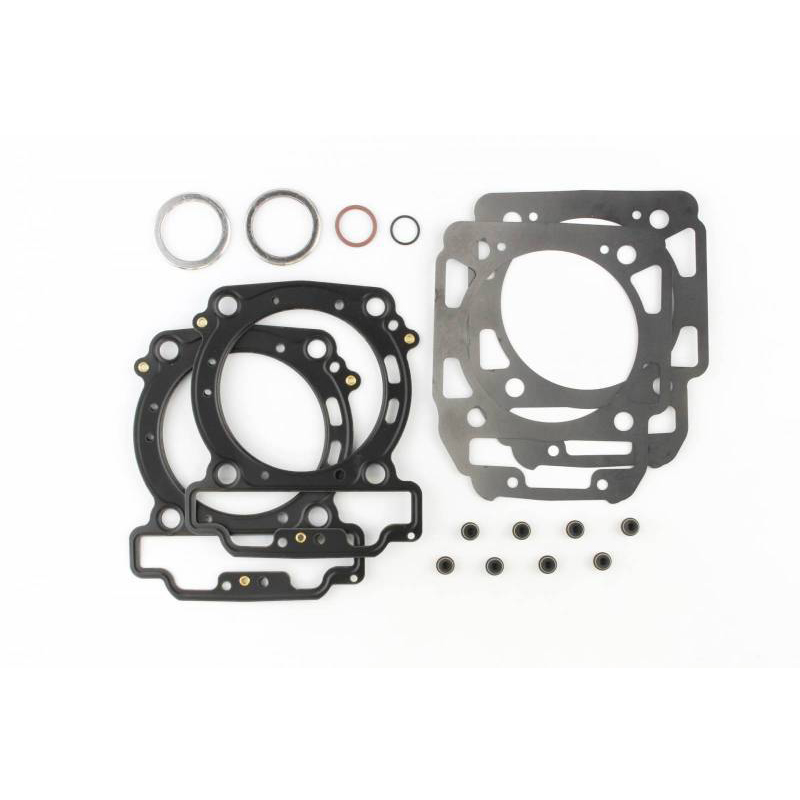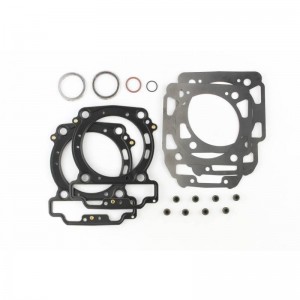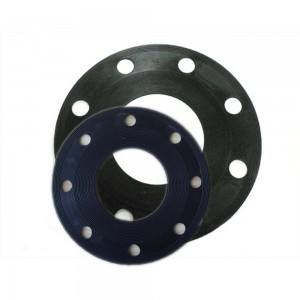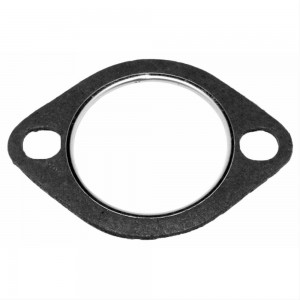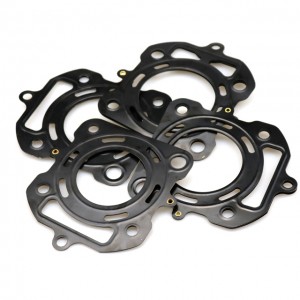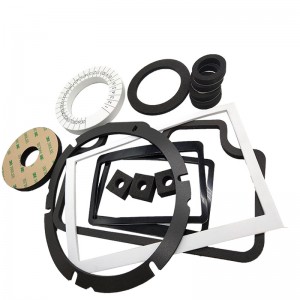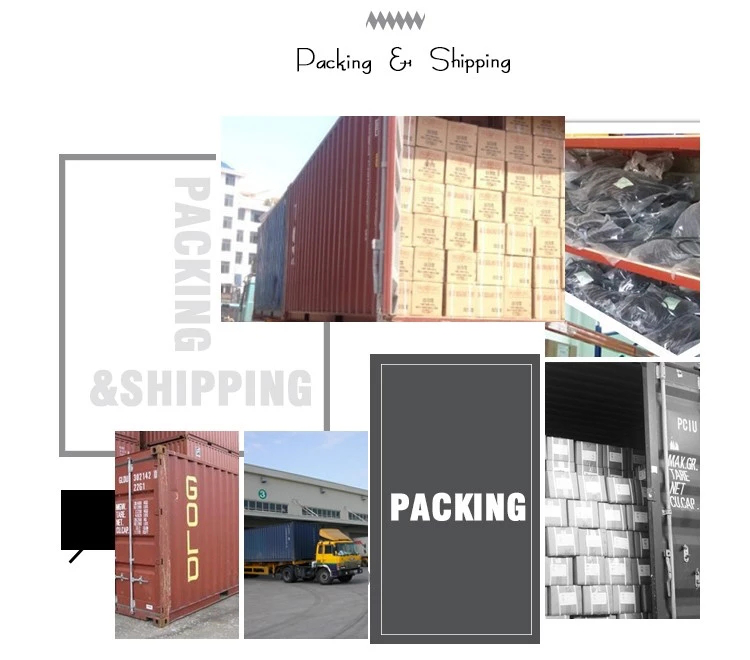ในการวางท่อ ปะเก็นคือวัสดุปิดผนึกที่วางอยู่ระหว่างหน้าแปลนเชื่อมต่อเพื่อสร้างซีลแบบคงที่ ซึ่งจะรักษาการปิดผนึกป้องกันการรั่วซึมในทุกสภาวะการทำงาน มีการใช้ปะเก็นประเภทต่างๆ เพื่อให้เกิดการซีลกันรั่วระหว่างหน้าแปลนท่อ หน้าที่หลักของปะเก็นคือการปิดผนึกความผิดปกติของแต่ละหน้าของหน้าแปลน เพื่อไม่ให้ของเหลวบริการรั่วไหลจากข้อต่อหน้าแปลน
ประเภทของปะเก็นที่จะใช้ในการให้บริการของเหลวนั้นขึ้นอยู่กับพารามิเตอร์ต่างๆ เช่น
1. อุณหภูมิ – วัสดุปะเก็นต้องทนต่อช่วงอุณหภูมิการออกแบบทั้งหมดของของไหลที่มันจัดการ
2. ความดัน – วัสดุปะเก็นต้องทนทานต่อช่วงแรงดันการออกแบบทั้งหมดของของเหลวที่วัสดุนั้นจัดการ
3. ความต้านทานการกัดกร่อน – วัสดุปะเก็นไม่ควรสึกกร่อนเมื่อสัมผัสกับของเหลวที่จับหรือจากการสัมผัสกับสิ่งแวดล้อม
4. ประเภทของของไหล – วัสดุปะเก็นควรจะสามารถจัดการกับของเหลวประเภทต่างๆ ได้หากติดตั้งในแนวที่รองรับของเหลวมากกว่าหนึ่งประเภท
5. ความทนทาน – ปะเก็นต้องสามารถทนต่อการเคลื่อนไหวทั้งหมดที่อาจเกิดขึ้นเนื่องจากการเปลี่ยนแปลงของอุณหภูมิและความดัน
6. ความพร้อมใช้งาน – ปะเก็นควรเป็นเรื่องง่าย
7. ต้นทุน – ปะเก็นราคาถูกและไม่น่าเชื่อถือไม่ควรใช้พร้อมๆ กัน ไม่ควรมีราคาแพง
การเลือกปะเก็น
การเลือกปะเก็นที่เหมาะสมขึ้นอยู่กับปัจจัยดังต่อไปนี้
ความเข้ากันได้ของวัสดุปะเก็นกับของเหลว
ความสามารถในการทนต่อแรงดัน-อุณหภูมิของระบบ
อายุการใช้งานของปะเก็น
สิ่งสำคัญคือต้องเข้าใจข้อกำหนดในการใช้งานเฉพาะก่อนตัดสินใจเลือกปะเก็น ปะเก็นต้องรักษาซีลไว้ตามระยะเวลาที่ยอมรับได้ต่อแรงปฏิบัติการทั้งหมดที่เกี่ยวข้อง มีคุณสมบัติที่สำคัญแปดประการซึ่งปะเก็นใด ๆ จะต้องมีเพื่อบรรลุเป้าหมายนี้ –
1. การซึมผ่านไม่ได้ – ปะเก็นไม่ควรมีรูพรุนกับของเหลวที่ถูกปิดผนึก
2. ความสามารถในการอัด – ปะเก็นควรบีบอัดเข้าไปในจุดไม่สมบูรณ์ของใบหน้าซีลหน้าแปลนเพื่อสร้างซีลเริ่มต้น
3. การผ่อนคลายความเครียด (ต้านทานการคืบ) – ปะเก็นไม่ควรแสดงการไหลอย่างมีนัยสำคัญ (คืบ) เมื่ออยู่ภายใต้ภาระและอุณหภูมิ การไหลดังกล่าวจะทำให้โบลต์คลายตัว ลดแรงตึงที่ผิวปะเก็น และทำให้เกิดการรั่วไหล
4. ความยืดหยุ่น – แม้ว่าปกติจะมีเสถียรภาพ แต่ในความเป็นจริงแล้ว หน้าแปลนจะเคลื่อนที่เล็กน้อยเมื่อเทียบกับอีกส่วนหนึ่งภายใต้อิทธิพลของอุณหภูมิและความดันในการปั่นจักรยาน ปะเก็นควรจะสามารถชดเชยการเคลื่อนไหวดังกล่าวได้
5. ความทนทานต่อสารเคมี – ปะเก็นควรทนทานต่อการโจมตีทางเคมีจากตัวกลางในกระบวนการที่กำลังจัดการ ในทำนองเดียวกัน วัสดุปะเก็นจะต้องไม่ปนเปื้อนในตัวกลางในกระบวนการ
6. ความต้านทานต่ออุณหภูมิ – ปะเก็นควรทนต่อผลกระทบของอุณหภูมิสูงสุดและต่ำสุดภายในกระบวนการและอุณหภูมิบรรยากาศภายนอกได้
7. ป้องกันการติด – ต้องถอดปะเก็นออกได้ง่ายหลังการใช้งาน
8. ป้องกันการกัดกร่อน – ปะเก็นต้องไม่ทำให้เกิดการกัดกร่อนของหน้าแปลน
ประเภทของปะเก็น
ปะเก็นที่ใช้ในกระบวนการวางท่อมีสามประเภท
ไม่ใช่โลหะ
เมทัลลิค
คอมโพสิต
| ไม่ใช่โลหะ | เมทัลลิก – ปะเก็นแหวน | คอมโพสิต |
| ปะเก็นใยหินชนิดไม่มีใยหินอัด (CNAF) | ปะเก็นแหวนวงรี | ปะเก็นแผลเกลียว |
| ปะเก็นพีทีพีอี | ปะเก็นแหวนแปดเหลี่ยม | ปะเก็นคอมโปรไฟล์ |
| ปะเก็นยาง | ปะเก็นโลหะ Jacketed |
วัสดุทั้งหมดได้รับการเคลือบสารป้องกันการติดทั้งสองด้านเพื่อปกป้องปะเก็นและตัวเครื่องได้ดียิ่งขึ้น
| วัสดุ | ประเภทปะเก็น | วัสดุ | แอปพลิเคชัน | อุณหภูมิช่วงสั้นสูงสุด |
| NCA-45 | ปะเก็นคอร์ก | ไม้ก๊อก/ยางสังเคราะห์ผสม | ทนน้ำมันปานกลางสำหรับงานซีลส่วนใหญ่: p ฝาครอบวาล์ว p กระทะน้ำมัน p กระทะเกียร์ | สูงถึง 200°C (392°F) |
| ซีเอ็มพี-4000 | ปะเก็นกระดาษ | วัสดุ MicroPore ที่ถูกบีบอัด ผสมผสานเมทริกซ์ใยสังเคราะห์ที่เป็นเอกลักษณ์และสารยึดเกาะยางไนไตรล์บิวทาไดอีนที่บ่มเต็มที่ | ความสามารถและคุณสมบัติการรักษาแรงบิดที่ดีเยี่ยมสำหรับ OEM และการใช้งานทางอุตสาหกรรม | สูงถึง 350°C (650°F) |
| เอชเอฟแอล-171 | ปะเก็นกระดาษ | สารยึดเกาะยางไนไตรล์บิวทาไดอีนที่บ่มเต็มที่ | การใช้งานหนักและทางอุตสาหกรรม: p เครื่องยนต์ดีเซล p ระบบส่งกำลัง p เครื่องทำความเย็น p ท่อ | สูงถึง 290°C (550°F) |
| เอชเอฟแอล-781 | ปะเก็นกระดาษ | วัสดุปะเก็นบวมที่ควบคุมด้วยสไตรีนบิวทาไดอีนและสารยึดเกาะยางธรรมชาติ | การซีลน้ำมันสำหรับงานหนัก เครื่องยนต์ดีเซล กระทะน้ำมัน หน้าปกหน้า | สูงถึง 290°C (550°F) |
| M5201 | ปะเก็นกระดาษ | วัสดุที่มีความหนาแน่นสูงพร้อมสารยึดเกาะยางไนไตรล์บิวทาไดอีนที่บ่มเต็มที่ | เครื่องยนต์ดีเซลงานหนักการใช้งาน: ทนน้ำมัน ความต้านทานน้ำมันเชื้อเพลิง | สูงถึง 290°C (550°F) |
| MP-15 | ปะเก็นกระดาษ | MicroPore พร้อมด้วยสารยึดเกาะ Nitrile Butadiene | ความสามารถรับแรงกดที่หน้าแปลนต่ำที่ดีเยี่ยมและการรักษาแรงบิดของโบลต์สำหรับการใช้งานหนัก: พี คอมเพรสเซอร์ พี เครื่องยนต์ดีเซล พี อื่นๆ | สูงถึง 205°C (400°F) |
| N-8092 | ปะเก็นกระดาษ | เซลลูโลสเสริมแรงด้วยสารยึดเกาะไนไตรล์ | ความต้านทานการกระแทกที่ดีเยี่ยมที่แรงดันหน้าแปลนสูงสำหรับเครื่องยนต์ดีเซลและการใช้งานคอมเพรสเซอร์: น.น้ำมัน น.เชื้อเพลิง น.น้ำ | สูงถึง 180°C (350°F) |
| พีเอฟ-4เอส | ปะเก็นกระดาษ | เส้นใยสังเคราะห์ สารตัวเติมขั้นสูง และสารยึดเกาะไนไตรล์บิวทาไดอีน | การใช้งานน้ำมัน อากาศ และสารหล่อเย็นต่างๆ: กระทะน้ำมัน หน้าปกหน้า p ท่อร่วมไอดี p ซีลด้านหลัง | สูงถึง 290°C (550°F) |
| วัสดุ | ประเภทปะเก็น | วัสดุ | แอปพลิเคชัน | อุณหภูมิช่วงสั้นสูงสุด | |
| RN8011 | กระดาษ | ปะเก็น | วัสดุเส้นใยเซลลูโลสความหนาแน่นต่ำที่มีปริมาณสารตัวเติมยางสูงและสารยึดเกาะยางไนไตรล์บิวทาไดอีน | การปิดผนึกที่ดีเยี่ยมที่แรงดันหน้าแปลนต่ำสำหรับการใช้งานน้ำมันและน้ำ: พี เครื่องยนต์ p ปะเก็นถาดเกียร์ พี ปั้มน้ำ p ซีลสิ่งแวดล้อม | สูงถึง 180°C (350°F) |
| S-8091 | กระดาษ | ปะเก็น | วัสดุผูกมัดสไตรีนบิวทาไดอีนแบบแฝงด้วยเส้นใยเซลลูโลสเสริมแรง | การปิดผนึกที่ดีเยี่ยมสำหรับ: พี ออยล์ พี เชื้อเพลิง p ไอน้ำแรงดันต่ำ | สูงถึง 180°C (350°F) |
| TS-9016 | กระดาษ | ปะเก็น | สารยึดเกาะยางสไตรีนบิวทาไดอีนบ่มเต็มที่และส่วนผสมของเส้นใยอะรามิดและเซลลูโลส | การใช้งานน้ำมันและน้ำ | สูงถึง 290°C (550°F) |
| วีบี-72 | กระดาษ | ปะเก็น | MicroPore พร้อมด้วยสารยึดเกาะ Nitrile Butadiene | การใช้งานหนัก: ตัววาล์ว p การใช้งานที่มีแรงดันของของไหลสูงและอัตราการไหลสูง p ความต้านทานการกัดกร่อน | สูงถึง 290°C (550°F) |
| อีเอ็มซี-7201 | โลหะ | ปะเก็น | โครงสร้างคอมโพสิตของปะเก็นประสานไนไตรล์บิวทาไดอีนที่มีความหนาแน่นสูงและแข็งตัวเต็มที่หันหน้าเข้าหากันทางเคมีและทางกลไกกับแกนเหล็กที่ขยายตัว | การใช้งานข้อต่อโครงสร้างเครื่องยนต์ดีเซลสมรรถนะสูง: p กล่องเกียร์ p เรือนมู่เล่ p ข้อต่อไฮดรอลิกแรงดันสูง | |
| HTX-900 7% | โลหะ | ปะเก็น | วัสดุเคลือบกราไฟต์ หันหน้าไปทางอุณหภูมิสูงทั้งทางเคมีและทางกล หลอมรวมกับแกนเหล็กที่ขยายตัว | ความแข็งแรงสูง ความสมบูรณ์ทางความร้อน และประสิทธิภาพการปิดผนึกที่ป้องกันการติด: ท่อร่วมไอเสีย p ส่วนหัว พี นักสะสม ประเก็นระบบ EGR | |
| ML6 | โลหะ | ปะเก็น | เส้นใยเซลลูโลสที่ไม่มีแร่ใยหินรวมกับลาเท็กซ์ไนไตรล์และเรซินเทอร์โมเซตติง | การใช้งานซีลรองรับโลหะที่มีประสิทธิภาพสูงและไม่อัดขึ้นรูป: ท่อร่วมไอดี ระบบส่งกำลัง ระบบเบรก การใช้งานในอุตสาหกรรม | สูงถึง 205°C (400°F) |
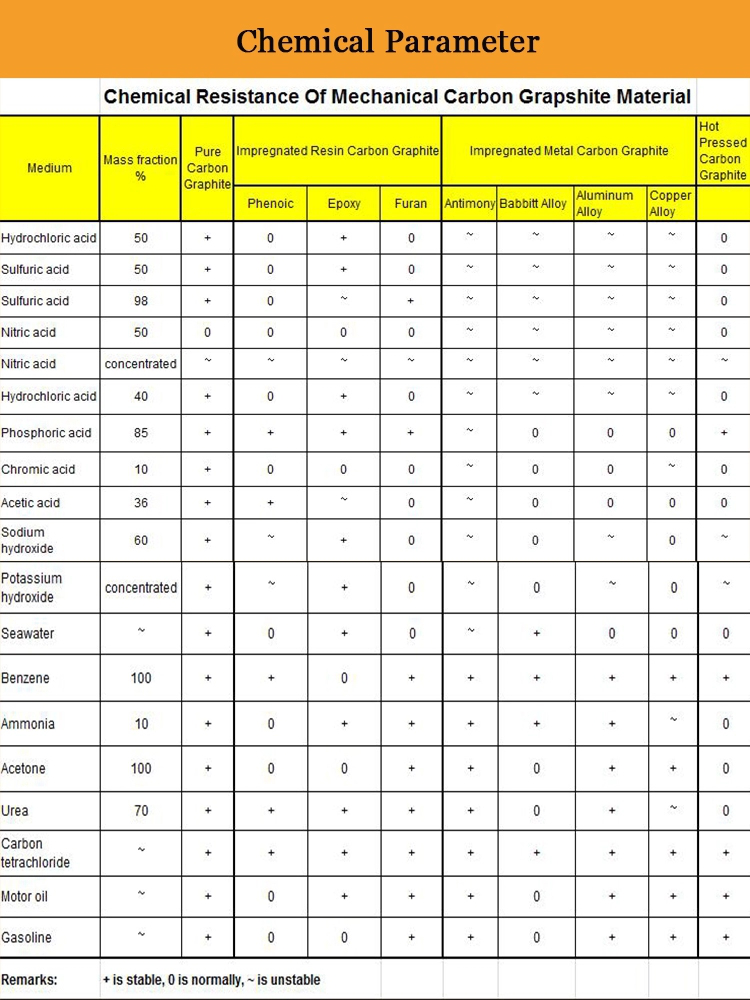
ขัด, ขัด, อโนไดซ์, ชุบโครเมี่ยม, ชุบสังกะสี, ชุบนิกเกิล, ย้อมสี ฯลฯ


